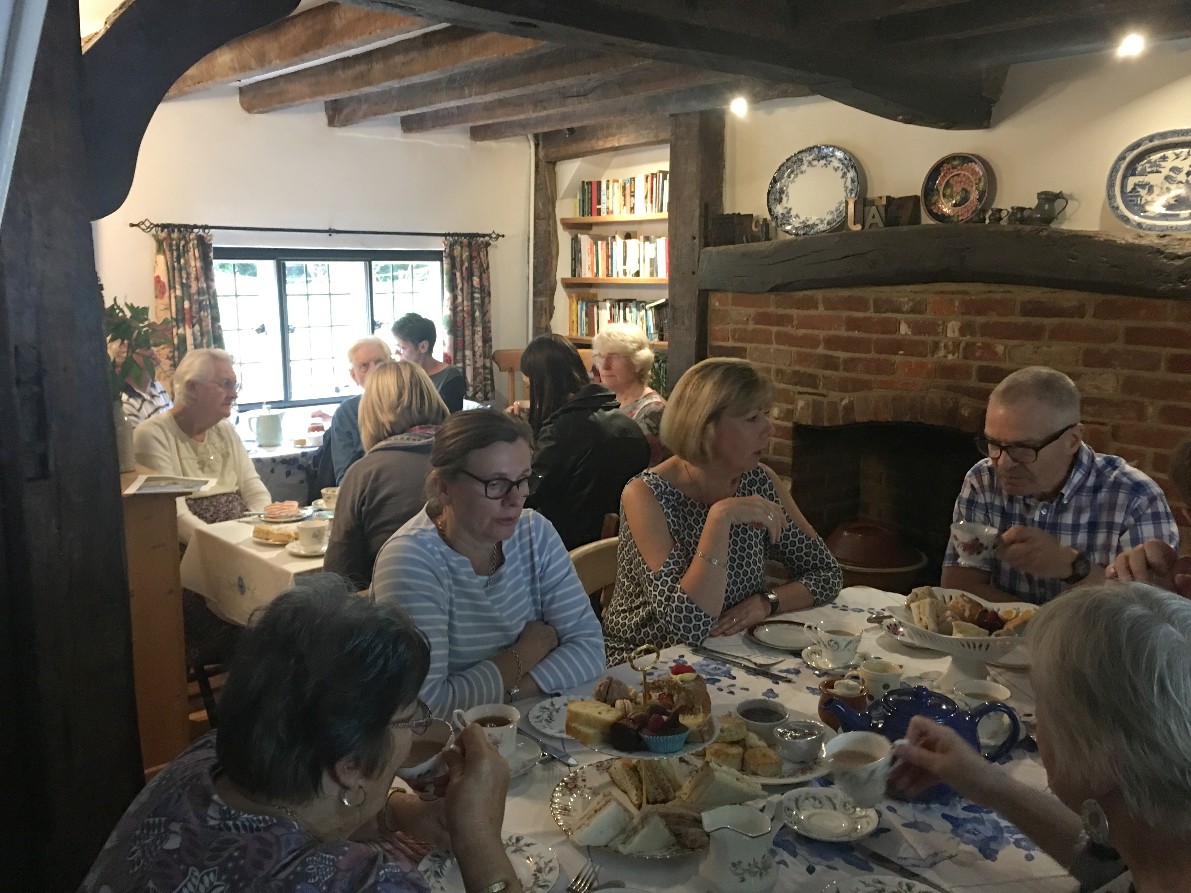|
   |
|
Page 4 |
Newsletter 119, Winter 2017 © Hampshire Mills
Group |
Pilcot Mill Open Day
Julie Banks
 |
On Friday 15 September I opened my
home and adjoining watermill to the public. This
was a charity event to support All Saints’ Church,
Dogmersfield.
57 people bought tickets for the
event and the plan was for them to enjoy a relaxed
afternoon tea sitting out in the sunshine in the
beautiful garden.
|
|
Unfortunately heavy rain with thunder
storms were forecast. I decided it would be
necessary to accommodate all guests within the
house. With this number of people it was a severe
challenge to find enough seating space.
|
 |

|
|
Fortunately I was supported by an
enthusiastic volunteer team from the village. These
ladies worked tirelessly ferrying food from kitchen
to tables in adjoining rooms. This meant all
visitors were provided with a magnificent cream tea
including strawberries and cakes. The seating area
was crowded but it is fair to say a good time was
had by all.
Throughout the afternoon tours of the
watermill were available. My son Matthew
effectively managed the demanding task of providing
a constant controlled flow of visitors from house to
the watermill. It was fortunate that the threatened
heavy rain never materialised. Otherwise everyone
would have got very wet during this period. I was
ably supported by Peter Mobbs of HMG, without whose
help, the mill tours would have been far more
challenging and a lot less interesting
I had prepared informative
illustrated sheets for each guest. These provided
both the history and technical features of the mill
(shown below), together with a general description
of the workings of a watermill. Feedback received
indicated that everyone enjoyed their mill tour.
The consensus was that the day was a
great success story combining the virtues of raising
money for a good cause and promoting interest in our
milling heritage.
|
|
Description of the mill
Pilcot Mill is a three story building
separate from the mill house. It is timber-framed
with brick infill and the upper storey is
weather-boarded. The tiled roof is half hipped. A
mill is recorded in the Domesday Book on the site of
the existing mill which dates to around 1750.
An external iron Poncelet waterwheel
is still in place, the original buckets have been
removed due to corrosion. Outside the mill at the
southern end is the base of an engine. The stream
that powered the wheel floods easily and has two
bypass channels adjacent to the wheel-pit. The pit
wheel and all the original machinery are still in
the mill including two pairs of stones, one of which
is French burr. The pulleys for the internal hoist
as well as the grain bins and chutes are intact.
Major renovation work was undertaken
in the 1990’s by Anne and Geoff Finnigan, the
parents of the present owner, Julie Banks. A new
schedule of work has been drawn up and will commence
shortly.
The mill is a Grade 2 listed
building.
A mill on the same site is
recorded in the Domesday Book and a water mill is
known to have existed there in the 15th, 16th,
and 17th centuries.
History |
|
1753
John Gilham, miller, Pilcot Mill applies for a
marriage licence.
1788 To
be sold by auction at The George Inn, Odiham. A
freehold water corn mill situated in the parish of
Dogmersfield called Pilcot Mill, with the dwelling
house, yard, garden stable etc now in the occupation
of Peter Bazeley, Miller.
1875
Frederick
Eddar, miller, Pilcot Mill
1878
John T A Howkins, miller, Dogmersfield
1880 C
Shirwell, miller, Pilcot Mill
|
1895
George Wright Jnr Miller
1940’s-60’s
Mill owned by Amy Clutton
1970’s-1988
owned by Mrs & Mrs Sanders, Red
Cottages
1988-2009
owned by Geoff & Anne Finnigan
2009 to date
owned by Julie Banks & Peter Finnigan
|
|
Pilcot Mill Waterwheel Axle
Dave Plunkett
Further to the report by Julie Banks
on the Pilcot Open Day event I can add news about
the repairs that were being planned during the past
few months to save the waterwheel’s axle, instead of
wholesale replacement. The axle was renewed about
30 years ago.
Back in July this year I prepared an
inspection report on the mill of which the major
item was the waterwheel and attendant construction.
The waterwheel’s oak axle has not been turned since
it was last renewed, so the top area has been
exposed to the elements all this time. The outer
supporting gudgeon has suffered and started to
become loose and the axle is subject to some decay
over a large area.
Advice was taken on how to repair the
axle, and an engineering solution developed to a
millwrighting problem, as the most economical
method of repair. We now have a scheme with
drawings and calculations to support the proposed
repair.
|
 |
 |
During late October the waterwheel
chamber silt was dug out and pumped dry with the
generous help of a Dogmersfield neighbour. I have
further investigated the degree of timber decay and
cut out a large knot hole in the top surface, and
drilled small deep test holes around the axle to
determine where the axle should be cut off.
Recently the large knot hole and three test holes
have received consolidating resin to ensure the core
near the cut–off is sound.
Advice from the Lime Centre at
Morestead has led to the use of lime mortar and
timber preserver, and some pressure washing of walls
and waterwheel areas has taken place. |
| |
|
|
   |
|
|
